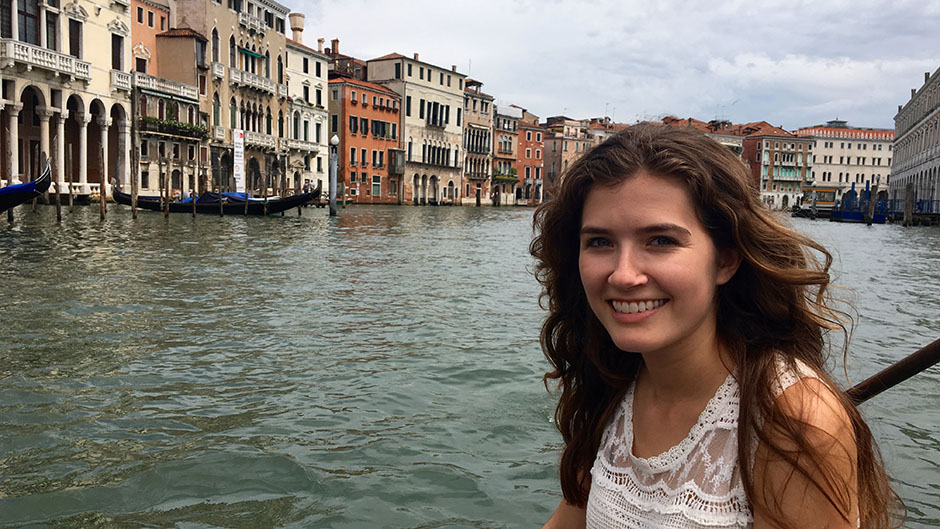In the dark of the night, Perina Marigi carefully climbed over the wall of her parish church’s graveyard in hopes to extract human remains for future rituals. As a practitioner of magic in 16th century Venice, the bones were essential to her practice and without them she wouldn’t be able to conjure the spirits necessary to her magic.
Just as she made headway with her mission, she was abruptly caught in the act. In that moment, she knew very well that the crime would expose her involvement with witchcraft, yielding many uncertainties for her future.
Accounts like Marigi’s may sound like a Hollywood script of witchcraft and wizardry folklore, but more than 200 years later at the University of Miami, historians are working to shed light on early modern acts of darkness.
When Anna Bennett, a third-year Ph.D. student in the Department of History, speaks of Marigi’s story, it’s as if she were present in Venice during the 16th century trial with The Holy Office. She credits her vast knowledge on the subject to her time with UM’s Department of History and shared that without that support she may not have had the opportunity to unlock stories of ancient Venetian witchcraft that have otherwise remained unexplored.
In 2016, while in Venice on a department-funded research grant, Bennett spent long hours in the confines of the Venetian state archives, where Holy Office records are kept. Housed in what was once a monastery, the building contains vast record collections, including boxes of court documents containing first-hand accounts of accused witches on trial for endangering local civic and religious order.
“The court documents within the archives offer a different perspective when studying historical accounts of witchcraft and magic,” said Bennett. “By reading against the grain, I was able to draw out details of social and cultural history through the voices of ordinary people,” she added.
According to Bennett, these ordinary voices revealed extraordinary insights into the life of an accused witch in 16th century Venice.
For weeks, Bennett meticulously scoured the documents for cases where stregamenti, or witchcraft objects, played a large role in the accusations. As she went through the boxes of court documents, each fragile page required delicate turning and aside from the delicate state of the paper, she faced the challenge of translating hand-written documents that seamlessly transitioned between Latin and Venetian Italian, a dialect unique to the region. Though an arduous process, her attention to detail unveiled that stregamenti often played a profound role in 16th century Venetian witchcraft trials.
As Bennett’s research continued, her interest in the use of objects heightened. In numerous court cases accusers and witnesses referred to the use of conventional items—from wax and sewing needles to kitchen herbs and beans—that were seemingly transformed into powerful transmitters of magic. Ironically, some of the items mentioned in bewitching rituals, like holy oil and communion wafers, were also used by those practicing more orthodox forms of faith within the confines of their churches.
Bennett explained that in her research, the irony of the many situations didn’t stop at the objects. In fact, many women who practiced magic were portrayed as healers until their healing powers and rituals failed their patients. In a specific case, the Buranelle sisters were visited by patients unable to afford care outside of, or in addition to, formal medical treatment. Viewed as healers in the community, the sisters used everyday objects to perform magic on those who sought out their services.
“At the time, popular magic was not only coexisting, but in some cases was competing with traditional forms of healing or medical treatment,” said Bennett.
In the Buranelle case, Holy Office documents revealed that in desperation a woman brought her injured son to the healers in hopes of curing a pain in his abdomen. Dionora Buranelle treated the boy with wine and biscuits made by nuns. The spiritual connotations of the food in combination with the healing ritual was sure to be the cure. However, when the boy become ill, the mother suspected and accused the sisters of witchcraft. Brought to trial, the accusation of their witchery is just one of the many accounts within Holy Office records where the practice of good and evil were subjective.
The idea that objects could be both good and evil, depending on their use or handler, prompted Bennett to dig further. Without a universal definition of witchcraft, she needed to understand how so-called witches in Venice differed from others in Europe at the time and if their objects were unique to their work.
In addition to iconic images of 17th century European witches chanting around a bubbling cauldron and accounts of mass burnings at the stake, modern-day stories have instilled the idea that eye of newt and leg of frog are essential ingredients for conjuring magical spirits or creating mystical potions. In her research, Bennett found nothing of the sort.
In fact, Venetian witches didn’t usually seem interested in creating havoc on their communities. Instead, they focused on rituals and objects that could address daily life problems and could help them overcome challenges.
Bennett’s focus on stregamenti within Venetian witchcraft has led her down a path that many others have not explored. Her work continues to shed light on the unique character of witchcraft, and its material components in 16th century Venice.
“Historical sources like Holy Office records are valuable in helping us better understand past cultures and societies. When educating others on the nature of early modern witchcraft, objects and their layers of meaning and use can act as vital evidence to modern historians, just as they once did for early modern Venetians,” said Bennett.
As her research reshapes many modern-day notions related to witches, it’s natural to question if their intentions were ever a matter of good versus evil.

